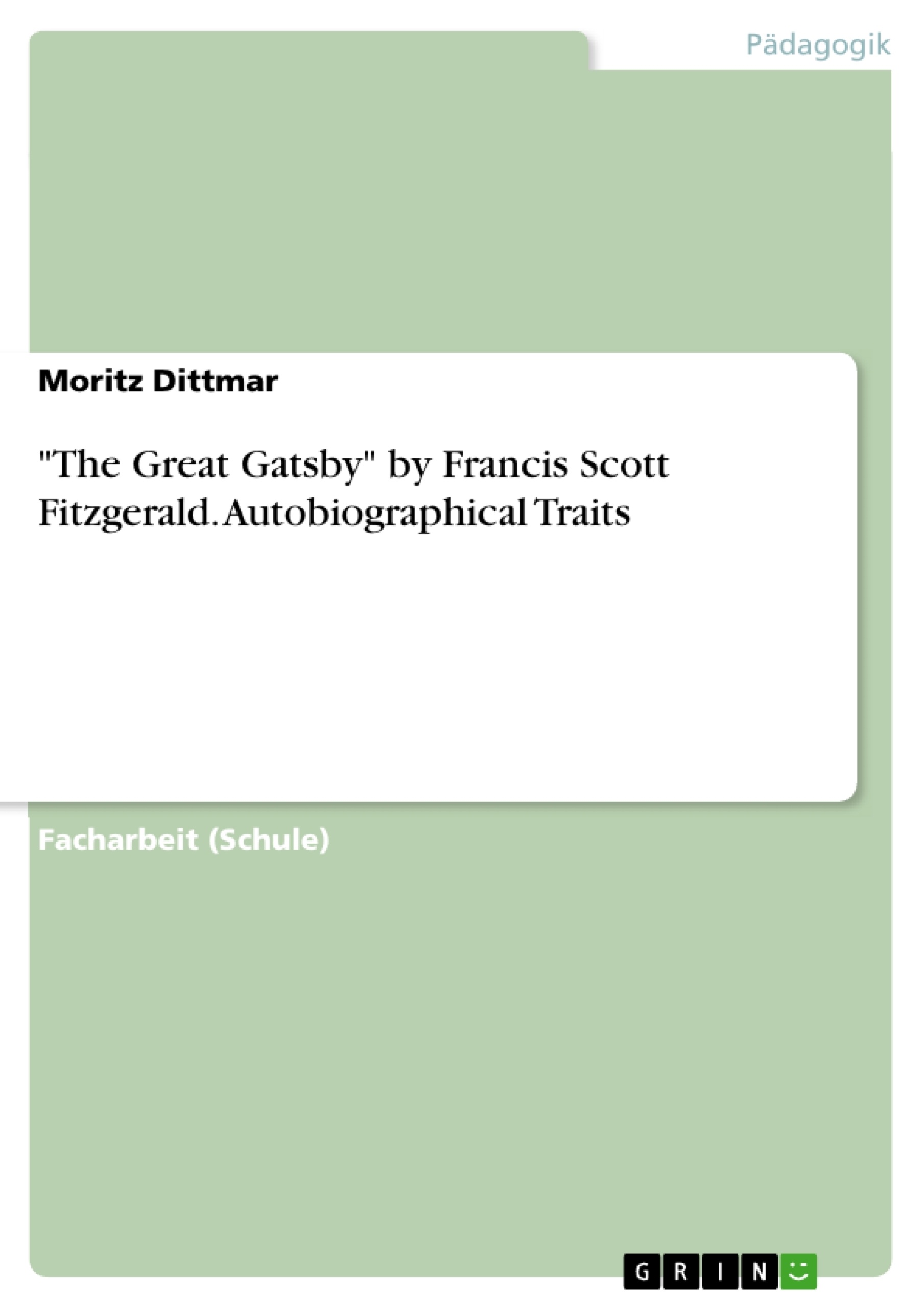Die von mir erstellte Facharbeit im Leistungskurs Englisch behandelt die Autobiografischen Züge des Romans "The Great Gatsby" und erklärt die Parallelen die Francis Scott Fitzgerald in seinem Roman eingebaut hat.
Inhaltsverzeichnis
- Introduction
- The Author
- Summary
- Autobiographical elements in novels
- Autobiographical Traits
- Relationship with Zelda / Daisy
- Desire for success through failure / Alcoholism
- Time / Lifestyle
- Is „The Great Gatsby“ an autobiography?
- Ist „The Great Gatsby“ easier to understand after reading Fitzgerald's biography?
Zielsetzung und Themenschwerpunkte
Diese Arbeit untersucht den Einfluss autobiografischer Elemente in F. Scott Fitzgeralds Roman „The Great Gatsby“. Ziel ist es, die Verbindung zwischen Fitzgeralds Leben und seinem Werk aufzuzeigen und zu analysieren, inwiefern die Kenntnis der Biografie das Verständnis des Romans verbessert.
- Autobiografische Elemente in „The Great Gatsby“
- Parallelen zwischen Fitzgeralds Leben und der Figur des Jay Gatsby
- Der Einfluss von Fitzgeralds persönlichem Hintergrund auf den Roman
- Die Darstellung der „Roaring Twenties“ und deren Reflexion in Fitzgeralds Biografie
- Die Frage nach der Autobiografizität des Romans
Zusammenfassung der Kapitel
Introduction: Diese Einleitung führt in das Thema der Arbeit ein und stellt den Roman „The Great Gatsby“ sowie dessen Autor, F. Scott Fitzgerald, kurz vor. Sie skizziert die zentrale Forschungsfrage nach dem Einfluss von Fitzgeralds Biografie auf das Verständnis des Romans und kündigt den weiteren Aufbau der Arbeit an. Die Bedeutung des Romans als Spiegelbild der „Roaring Twenties“ wird hervorgehoben.
The Author: Dieses Kapitel bietet einen biografischen Abriss über F. Scott Fitzgerald, beginnend mit seinen frühen Jahren, seiner Zeit an der Princeton University und seinem Militärdienst. Es beschreibt Fitzgeralds Weg zum Erfolg mit seinem ersten Roman „This Side of Paradise“, seinen Aufstieg als gefeierter Autor der „Jazz Age“, seinen späteren Abstieg aufgrund von Alkoholismus und finanziellen Problemen, sowie sein letztendliches Ableben in Hollywood. Die Beschreibung seines Lebenswegs dient als Grundlage zum Vergleich mit den autobiografischen Elementen im Roman.
Summary: Diese Zusammenfassung fasst die Handlung von „The Great Gatsby“ zusammen. Sie stellt die Hauptfiguren Nick Carraway und Jay Gatsby vor, beschreibt Gatsbys geheimnisvolle Persönlichkeit und seine unglückliche Liebe zu Daisy Buchanan. Die tragische Entwicklung der Handlung, einschließlich des tödlichen Unfalls und Gatsbys Tod, wird skizziert, wobei der Fokus auf den zentralen Konflikt zwischen Gatsby und Tom Buchanan liegt. Der Ausschluss von Nick aus dem Leben von Tom und Daisy am Ende unterstreicht die Traurigkeit und Sinnlosigkeit von Gatsbys Bemühungen.
Autobiographical elements in novels: Dieses Kapitel analysiert den Begriff des autobiografischen Romans und klärt den Unterschied zwischen einem rein autobiografischen Werk und einem Roman mit autobiografischen Elementen. Es wird der „autobiografische Pakt“ diskutiert, sowie die Methoden, wie Autoren autobiografische Erfahrungen in fiktive Erzählungen integrieren, wobei die Möglichkeiten der Übertreibung und Veränderung der Realität im Interesse der literarischen Gestaltung betont werden.
Schlüsselwörter
„The Great Gatsby“, F. Scott Fitzgerald, Autobiografische Elemente, „Roaring Twenties“, Jay Gatsby, Daisy Buchanan, Alkoholismus, Erfolg und Scheitern, amerikanischer Traum, biografische Parallelen, literarische Analyse.
Häufig gestellte Fragen zu: Autobiografische Elemente in F. Scott Fitzgeralds „The Great Gatsby“
Was ist der Gegenstand dieser Arbeit?
Diese Arbeit untersucht den Einfluss autobiografischer Elemente in F. Scott Fitzgeralds Roman „The Great Gatsby“. Sie analysiert die Verbindung zwischen Fitzgeralds Leben und seinem Werk und untersucht, inwiefern die Kenntnis seiner Biografie das Verständnis des Romans verbessert.
Welche Themen werden behandelt?
Die Arbeit behandelt autobiografische Elemente in „The Great Gatsby“, Parallelen zwischen Fitzgeralds Leben und der Figur Jay Gatsby, den Einfluss von Fitzgeralds persönlichem Hintergrund auf den Roman, die Darstellung der „Roaring Twenties“ und deren Reflexion in Fitzgeralds Biografie sowie die Frage nach der Autobiografizität des Romans.
Welche Kapitel umfasst die Arbeit?
Die Arbeit beinhaltet eine Einleitung, ein Kapitel über den Autor F. Scott Fitzgerald, eine Zusammenfassung der Handlung von „The Great Gatsby“, ein Kapitel über autobiografische Elemente in Romanen und abschließend eine Zusammenfassung der Schlüsselwörter.
Wie wird die Biografie von F. Scott Fitzgerald in die Analyse einbezogen?
Die Biografie Fitzgeralds, von seinen frühen Jahren bis zu seinem Tod, wird als Grundlage für den Vergleich mit den autobiografischen Elementen im Roman verwendet. Es wird der Einfluss seines Lebenswegs auf sein Werk untersucht.
Wie wird die Handlung von „The Great Gatsby“ zusammengefasst?
Die Zusammenfassung stellt die Hauptfiguren Nick Carraway und Jay Gatsby vor, beschreibt Gatsbys geheimnisvolle Persönlichkeit und seine unglückliche Liebe zu Daisy Buchanan. Die tragische Handlungsentwicklung, einschließlich des tödlichen Unfalls und Gatsbys Tod, und der zentrale Konflikt zwischen Gatsby und Tom Buchanan werden skizziert.
Was wird unter „autobiografischen Elementen in Romanen“ verstanden?
Dieses Kapitel analysiert den Begriff des autobiografischen Romans und den Unterschied zwischen einem rein autobiografischen Werk und einem Roman mit autobiografischen Elementen. Der „autobiografische Pakt“ und die Methoden, wie Autoren autobiografische Erfahrungen in fiktive Erzählungen integrieren, werden diskutiert.
Welche Schlüsselwörter charakterisieren die Arbeit?
Schlüsselwörter sind: „The Great Gatsby“, F. Scott Fitzgerald, Autobiografische Elemente, „Roaring Twenties“, Jay Gatsby, Daisy Buchanan, Alkoholismus, Erfolg und Scheitern, amerikanischer Traum, biografische Parallelen, literarische Analyse.
Verbessert die Kenntnis von Fitzgeralds Biografie das Verständnis von „The Great Gatsby“?
Die Arbeit untersucht genau diese Frage. Sie analysiert, inwieweit Parallelen zwischen Fitzgeralds Leben und den Geschehnissen im Roman das Verständnis der Handlung, der Charaktere und der Thematik vertiefen.
Welche zentrale Forschungsfrage wird gestellt?
Die zentrale Forschungsfrage lautet: Wie beeinflusst die Kenntnis von F. Scott Fitzgeralds Biografie das Verständnis seines Romans „The Great Gatsby“?
- Citation du texte
- Moritz Dittmar (Auteur), 2013, "The Great Gatsby" by Francis Scott Fitzgerald. Autobiographical Traits, Munich, GRIN Verlag, https://www.grin.com/document/231625



